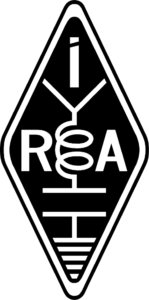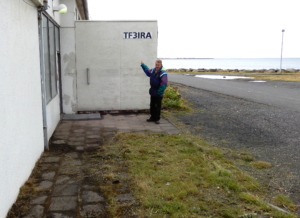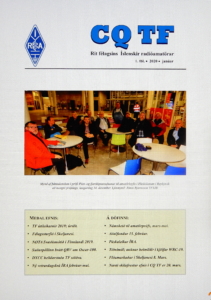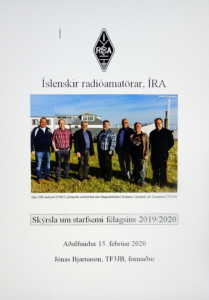 .
.
ÍSLENSKIR RADÍÓAMATÖRAR, ÍRA
.
About ÍRA
Icelandic Radio Amateurs (ÍRA) was founded on August 14, 1946. ÍRA is the national association of Icelandic radio amateurs and is recognized as such by the Electronic Communications Office of Iceland (ECOI). ÍRA is a member society of the IARU, IARU Region 1, and the Nordic Amateur Radio Union, NRAU. The association celebrated its 75th anniversary in 2021. In February 2023 we had just over 200 members.
Headquarters at Skeljanes
Our headquarters is located at Skeljanes street in Reykjavík and is open ever y Thursday, from 20-22 (except on national holidays). Our hq. is located at the south end of the street (close to Reykjavík airport).
y Thursday, from 20-22 (except on national holidays). Our hq. is located at the south end of the street (close to Reykjavík airport).
Members and guests are invited to drop by and usually approx. 20-30 members do so every week for a cup of coffee, a chat and to read the latest amateur radio magazines. We also have back issues at hand of our own magazine, CQ TF, which is published quarterly in PDF form on our website, www.ira.is Our club station, TF3IRA, is also located at Skeljanes.
The Skeljanes street has the position: 64° 07′ 33″ N – 21° 56′ 58″ W. Locator is HP94ad, 14 km from the south end and 2.5 km from the west end of the grid area. Bus route number 12 terminates outside headquarters. The photograph to the right shows the entrance to our hq.
.
The Executive Committee 2024/25
| President | Jónas Bjarnason | TF3JB (Cellular/GSM tel. 898-0559) |
| Vice President | Andrés Þórarinsson | TF1AM |
| Secretary | Georg Kulp | TF3GZ |
| Treasurer | Jón Björnsson | TF3PW |
| Board Member | Njáll H. Hilmarsson | TF3NH |
Executive Committee substitute members: Sæmundur Þorsteinsson, TF3UA.
Executive Committee substitute member: Heimir Konráðsson, TF1EIN.
The E-mail address of the association: ira@ira.is
Letters and QSL Cards to the ÍRA TF QSL Bureau should be addressed to the following address:
Íslenskir Radíóamatörar, ÍRA
Pósthólf 1058
IS-121 Reykjavík
Iceland
E-mail: ira@ira.is
E-mail: yota@ira.is (Elín Sigurðardóttir, TF2EQ, is ÍRA Youth Co-ordinator).
(Updated: October 28, 2024/TF3JB). More information continues below.
The website of Icelandic Radio Amateurs, ÍRA.
.
Below:
-
Information about Icelandic Radio Amateurs (ÍRA); the national association.
-
Information about operating in Iceland.
1. Icelandic Radio Amateurs
The association of Icelandic Radio Amateurs, ÍRA, was founded in 1946. The association is the national representative of Icelandic radio amateurs towards the IARU, IARU Region 1 and NRAU. In the Icelandic regulation for radio amateurs, the association has an official advisory role and liaison between Icelandic licensees and The Electronic Communications Office of Iceland (ECOI).
2. PTA Liaison
Maintaining a close relationship with the ECOI is one of the association’s priorities. Among tangible results are:
- Joint annual/semi-annual meetings between ÍRA and the ECOI, discussing amateur radio issues.
- Since 1972, the ÍRA has worked with the ECOI on amateur radio examinations in Iceland.
- Secondary privileges have been negotiated on the following bands: 70.000-70.250 MHz and 1850-1900 kHz (in certain international contests)
3. International Liaison and national society activities
As member society of the IARU / IARU Region 1 / NRAU, the ÍRA seeks to be as active in the international radio amateur scene as our limited funds allow.
To mention but a few of the local national society activities:
- Of major importance is our magazine, CQ TF, which is published quarterly. Ho
 wever, for five years (2013-2018) the magazine was not published. Nevertheless – as of April 2018 the magazis is again in full swing, published quarterly in PDF form on our website www.ira.is The most recent issue is July 2, 2023 (issue 3, 2023). To the right there is an example of the cover page of CQ TF (issue 1, 2020). The photo on the front page shows participants in the amateur radio examination at the University of Reykjavík on December 14, 2019.
wever, for five years (2013-2018) the magazine was not published. Nevertheless – as of April 2018 the magazis is again in full swing, published quarterly in PDF form on our website www.ira.is The most recent issue is July 2, 2023 (issue 3, 2023). To the right there is an example of the cover page of CQ TF (issue 1, 2020). The photo on the front page shows participants in the amateur radio examination at the University of Reykjavík on December 14, 2019. - The ÍRA Annual Report is issued once a year and presented in paper to member attending the annual meeting of ÍRA. It is also available in PDF form on our website www.ira.is Annual reports for the years 2018/19, 2019/20, 2020/21, 2021/22 and 2022/23 are available for download on the opening page at our website; www.ira.is A photo of the front page of the 2020 annual report is depicted on the right. The most recent annual report was issued on February 18, 2023 and is 239 pages.
- The association’s web page, www.ira.is is updated and maintained on daily basis, in order to keep our members informed about the latest happenings within the association and abroad.
- The web page also has a wealth of information on amateur radio (mostly though in Icelandic).
- Amateur radio courses and examinations are given 1-2 times per annum. The most recent one finished on May 21, 2022. It was held at the University of Reykjavík (HR) and parallel over the web. Eleven new licensees finished the examination successfully. Since that date, they have all been issued call signs by the PTA. The next course will be offered in September-November 2023 at HR.
- ÍRA established for the first time an EMC committee in year 2011. The committee seeks a close relationship with specialized bodies of other national societies and the IARU Region 1 EMC coordinator. Our EMC foreman is Mr. Sæmundur E. Þorsteinsson, TF3UA.
- ÍRA was the 2nd society in the world to translate and publish ON4UN’s “Ethics and Operating Procedures for the Radio Amateur” in 2009. It was translated to Icelandic by Mr. Vilhjálmur Í. Sigurjónsson, TF3VS. The publication was (and continues to be) distributed free to members.
- The TF ÍRA QSL Bureau is active throughout the year. Approx. 160 TF call signs have their designated boxes at
 the QSL Bureau.
the QSL Bureau.
5. Activities of the ÍRA
A few of the activities of our association:
- Our headquarters in Reykjavík are open to our members and guests once a week. Facilities are provided to sit down with a cup of coffee and look at the latest amateur radio magazines. Members also bring their outgoing QSL cards and collect incoming cards, as the IRA QSL Bureau is located on the premises.
- Our club station TF3IRA is QRV on HF, VHF and UHF (including satellites) and is open to licensed members and licensed guests. In contests we use the special call sign TF3W.
- The society offers an ambitious program of lectures and seminars that are given each year from February to May and from October to December. However, for a period of five years the program was not offered. Nevertheless, this was again started in the fall of 2018. This activity had to be closed down from March 2020 until October 2022 because of C0vid-19 and resumed in March-May 2023 and will be offered again in October-December 2023.
- VHF and UHF repeaters are QRV in the greater Reykjavík area and at a few other places in the country. We also have an APRS digipeater located at the ÍRA headquarters in Reykjavík (QRV as of October 12, 2019; call sign: TF3IRA-10).
- The society sponsors a TF Field day which is held annually on the HF bands in the first weekend in August. This event first took place in 1979. We celebrated the 40. event in 2019.
- The society also sponsors a VHF/UHF Field day in the first week of July. This event started in 2012.
- The society also sponsors a special VHF/UHF Easter Field day. This event started in 2018.
- Since its beginning in 1998, the ÍRA has actively supported participation in the annual International Lighthouse Lightship Weekend in August; the last such event in 2019 was at Knarrarós light house; special call sign TF1IRA.
- The Society supports CW code practice transmissions from the club station, TF3IRA, on the 80 meters (although not currently being offered).
6. VHF/UHF repeaters
See “Repeaters and frequencies” on the web page for more detailed information.
| TF1RPB, QTH: Bláfjöll mountain range near Reykjavík. QRG 145.650 MHz RX, -600, CTCSS 88,5 Hz tone access. |
| TF3RPA, QTH: Skálafell mountain near Reykjavík. QRG 145.600 MHz RX; -600
TF3RPK, QTH: Skálafell mountain near Reykjavík. QRG 145.575 MHz RX; -600 kHz; CTCSS 88,5 Hz tone access. |
| TF1RPE, QTH: Búrfell mountain east from Reykjavík. QRG 145.700 MHz RX; -600 |
| TF5RPD, QTH: Akureyri in the north of Iceland. QRG 145.625 MHz RX; -600 |
| TF2RPJ, QTH: Mýrar in the west of Iceland. QRG 145.750 MHz RX; -600 |
| TF3RPI, QTH: Bláfjöll mountain range near Reykjavík. QRG 439.950 MHz, -5 MHz D-Star gateway
7O CM LINK: |
7. Beacons on 6 meters and 4 meters
Beacon TF1VHF, QRG 50.457 MHz (in operation since May 17, 2018).
Beacon TF1VHF, QRG 70.057 MHz (in operation since May 17, 2018).
(Please note that both beacons use the same callsign, TF1VHF and are QRV 24 hours a day).
8. Local calling frequencies
| 2 Meters FM on 145.500 MHz and 2 Meters C4FM on 145.5625 MHz |
| 70 Centimeters FM on 433.500 MHz |
| 80 Meters SSB on 3637 KHz (mostly during weekends) |
| 80 Meters CW on 3525 KHz at 21:00 (currently not much activity) |
9. APRS
APRS digipeater activity is on 144.800 MHz; call sign: TF3IRA-10.
(Updated: October 28, 2024/TF3JB).
.
Operating in Iceland
Information for visiting Radio Amateurs – in Iceland.
1. Visitors with a valid Amateur Radio license from CEPT countries
(A) A Radio Amateur from a CEPT country who has a licence that equals the requirements of the CEPT license as is layed out in ECC Recommendation T/R 61-01 does not need to have a special license issued by the Icelandic government if he/she comes to Iceland for a short visit. As long as the visitors license in the home country does not run out, the person can operate when in Iceland for a period of up to 3 months. Should the period of stay exceed 3 months, the licensee can apply for an Icelandic callsign. In such a case, his home country needs to have ratified ECC Recommendation T/R 61-02. A special application form needs to be used and there is a fee. The fee is curently 2.800 ISK.
(B) If the radio amateur holds a valid novice license and comes from a CEPT country, his country needs to have ratified ECC/REC 05-06 in order for the licensee to be able to operate in Iceland.
(C) In all cases, CEPT licensees should only use the TF prefix in front of their call signs, but not the TF prefix with an Icelandic call area number. For example: TF/HB9XXX would thus be correct; but TF6/HB9XXX incorrect.
2. Visitors with a valid Amateur Radio license from countries which have implemented the T/R 61-01
(A) Radio Amateurs with a valid license from any of the following countries can operate in Iceland if the license in question equals the requirements for the CEPT license. They need not have a special license issued by the Icelandic government if he/she comes to Iceland for a short visit. As long as the visitors license in his home country does not run out, the person can operate when in Iceland for a period of up to 3 months. Should the period of stay exceed 3 months, the licensee can apply for an Icelandic callsign. In such a case, his home country needs to have ratified ECC Recommendation T/R 61-02. A special application form needs to be used and there is a fee. The fee is currently 2.800 ISK.
The Radio Amateur from any of the following countries needs to be sure that his/her license meets the standard of equivalence as is set out in Annex IV of “ECC Recommendation T/R 61-01”.
- Australia.
- Canada.
- Israel.
- Netherlands Antilles (i.e. Bonaire, Curacao, St. Eustatius, Saba and St. Maarten).
- New Zealand.
- Peru.
- South Africa.
- United States.
(B) If the radio amateur comes from one of the countries mentioned above and holds a valid “novice license” (or equivalent), his country needs to have ratified ECC/REC 05-06 in order for the licensee in question to be able to operate in Iceland. In the case of The United States, this license is “General class license”.
(C): Licensees from these countries should only use the TF prefix in front of their call signs, but not the TF prefix with an Icelandic call area number. For example: TF/W1XXX would thus be correct; but TF6/W1XXX incorrect.
3. Visitors with a valid Amateur Radio license from other countries
Radio Amateurs with a valid license from a country that has neither adopted the CEPT Agreement or with which there is nor a reciprocal agreement, need to obtain a special permit from the authorities to operate in Iceland. To be able to obtain a special permit, the licensee needs to demonstrate that his/her license fulfills the minimum requirements deemed satisfactory by the Icelandic PTA (the HAREC requirements or equivalent to those requirements). Applicants should allow ample time for the processing of requests of this nature and follow these steps:
- Fill out the relevant application forms found on the website of the Post and Telecom Administration.
- Include an unequivocal confirmation of the validity and class of your licence together with power and bands allowed.
- A copy of your licence and licensing conditions certified by a notary public (clear copies).
- A statement by your licensing authority.
- A statement by your national IARU society (if a member).
Kindly return your application to the PTA with the stipulated licensing fee (currently 2.800 ISK) or as instructed by the authority.
4. Importing Amateur Radio equipment to Iceland
Customs should not be a problem. However, if there is as problem, you can ask the customs officer to contact Mr. Hördur R. Hardarson at the Icelandic PTA, Póst- og fjarskiptastofnun. Please note that the ECC Recommendation T/R 61-01 does not cover custom regulations pertaining to Amateur Radio equipment in any way.
(Updated February 3, 2020/TF3JB).
